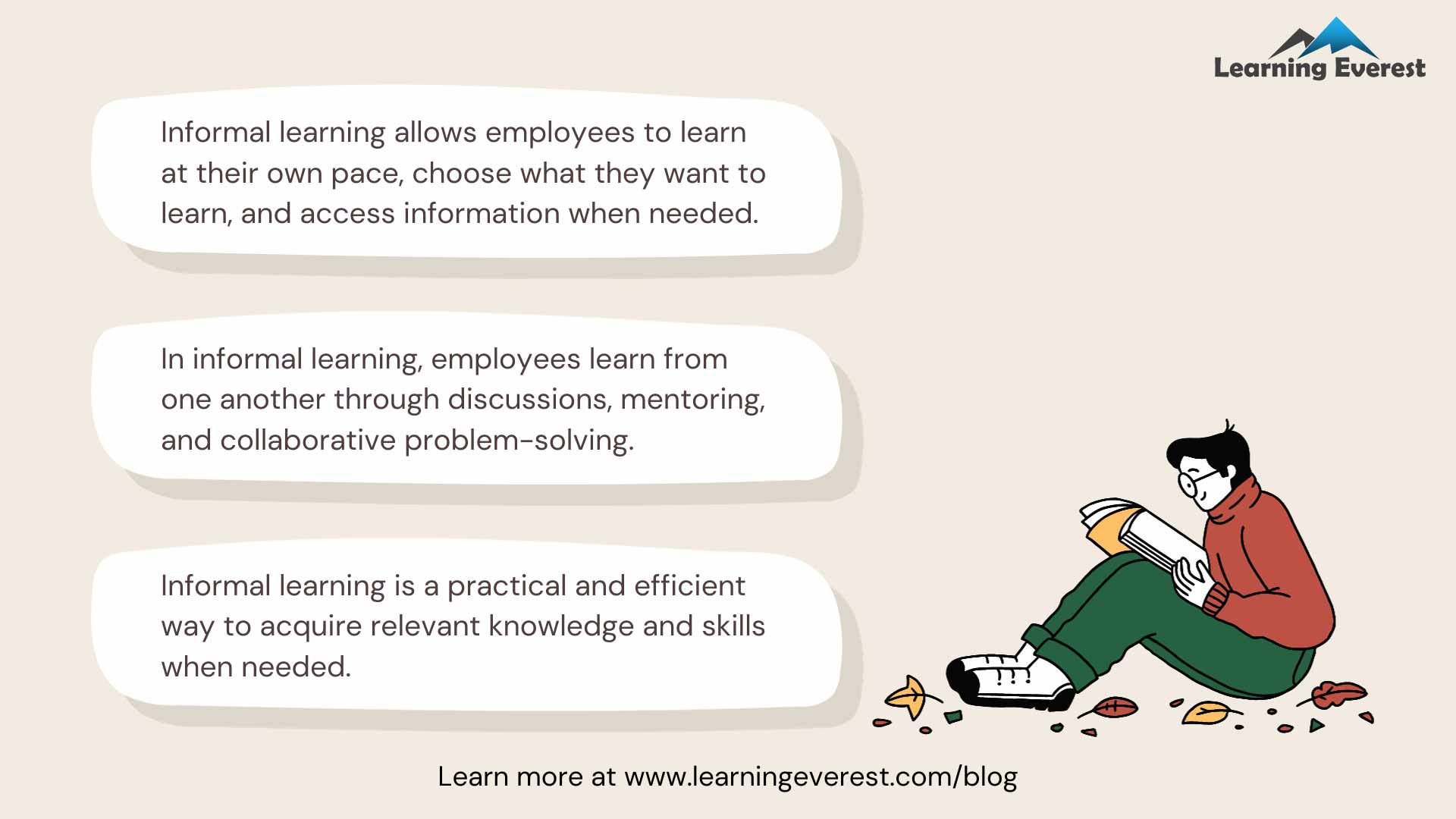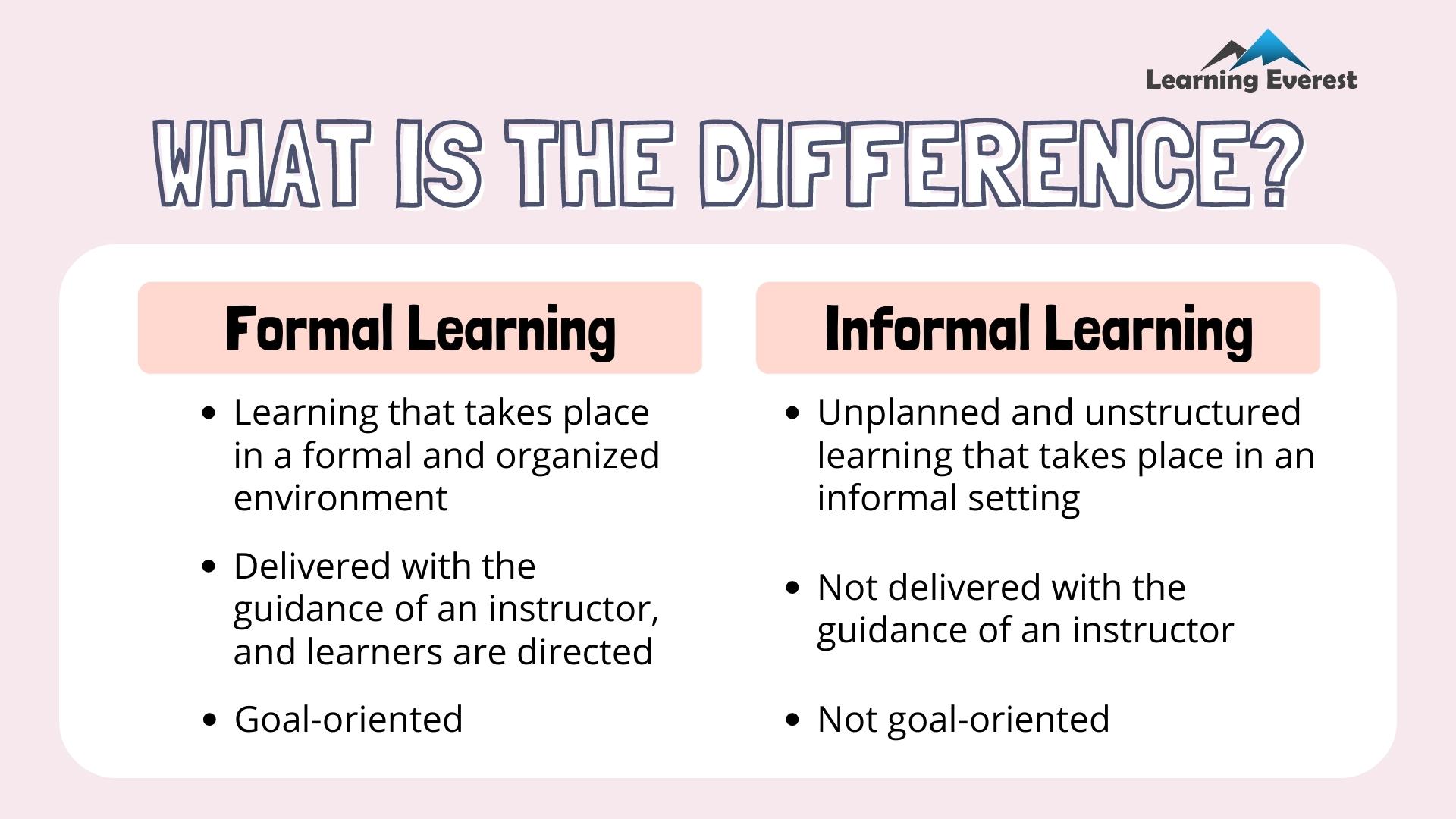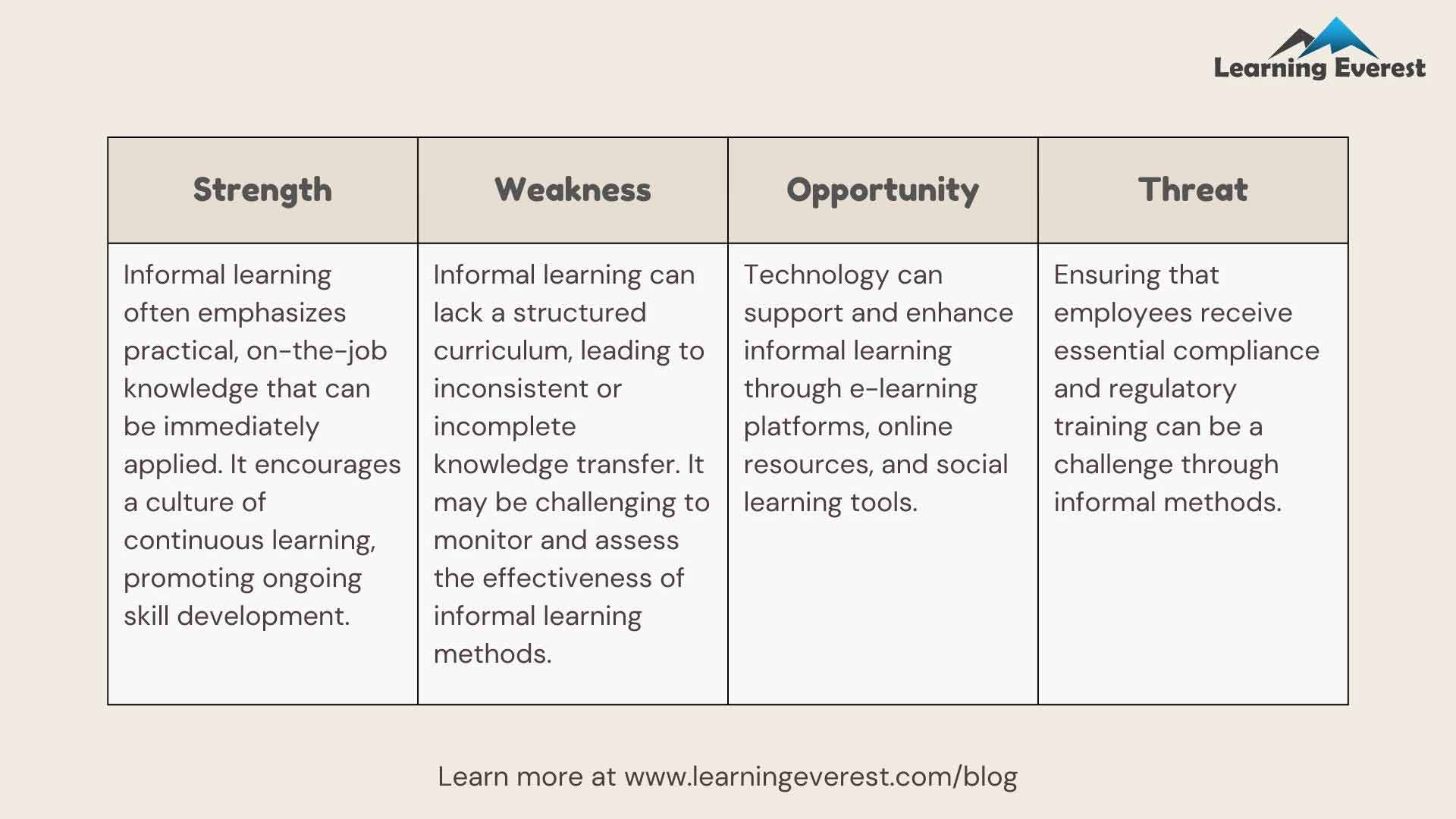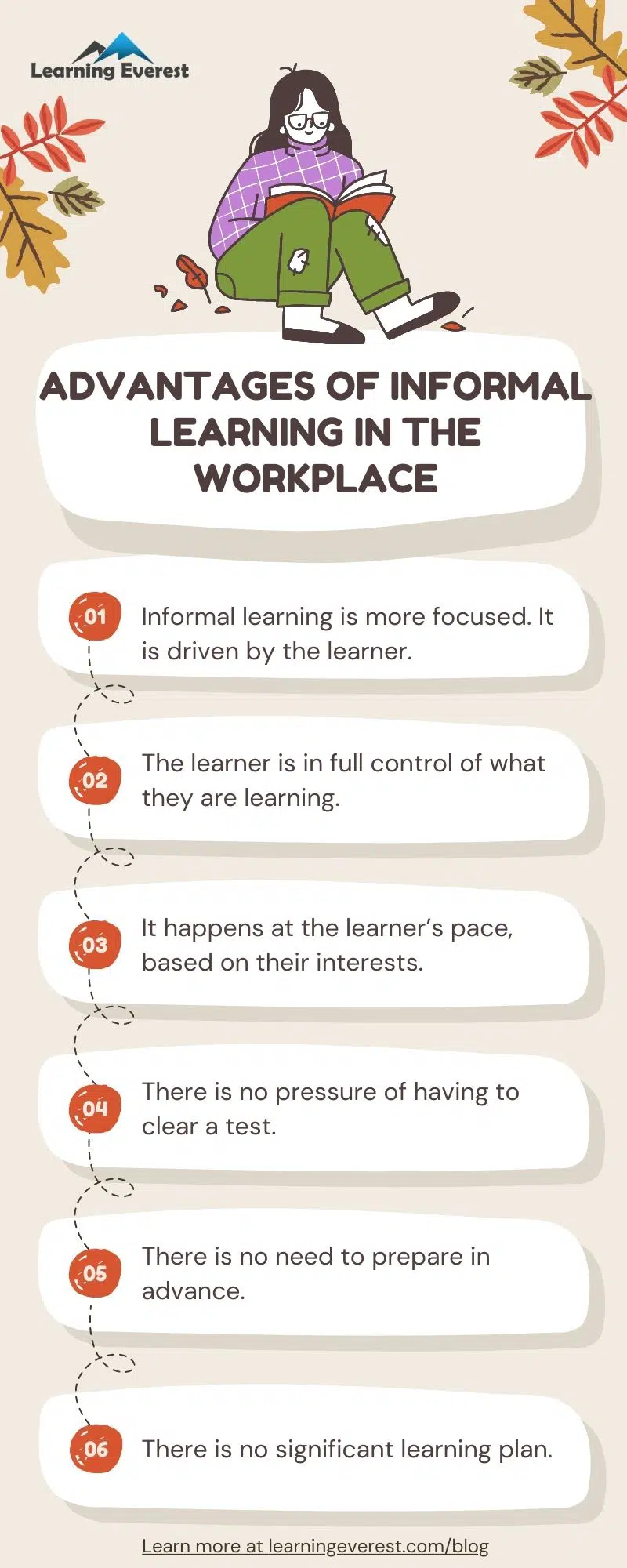The advantages of informal learning and formal learning in an organization are numerous. Learning and Development teams ensure that every employee gets proper training. How is it done? Formal and informal learning are two contrasting learning styles used within an organization.
Table of Contents
- What is Informal Learning?
- Formal Learning
- The term Informal Learning
- Benefits Informal Learning
- 70-20-10 model
- Cultivating Informal Learning in your Organization
- How can organizations encourage informal learning?
- Disadvantages of Informal Learning
- Infographics
- Knowledge Check
- Frequently Asked Questions (FAQs)
- What are the benefits of non-formal education?
- What is the importance of informal education?
- What are the significant characteristics of informal education?
- What are the advantages of informal education?
Understanding these learning styles will help you determine which learning practice will work best for your organization. Availability of learning resources is increasing, and they are becoming more accessible. Therefore, the amount of informal learning happening in workplaces also increases.
In this article, we will discuss Informal learning.
What is Informal Learning?
Informal learning is unstructured and happens outside of a conventional learning setting. It is self-directed, asynchronous, and has no fundamental objectives; instead, it occurs naturally. It can occur when two employees talk to each other. It is difficult to identify ways to use informal learning within your organization. A learner’s passion for learning drives informal learning.
In informal learning, the control is in the hands of the learner. One can choose from the various learning resources available based on their preferences and interests. Informal learning does not have any set methodology. It is spontaneous and can happen at any time.
A learner who spends time in informal learning is a goal-orientated person and on the lookout to expand their career, experiment, and consistently learn. Informal learning happens in a workplace without the learners involved in it knowing—a talk by employees during their break, the discussion regarding a meeting.
It is a self-guided type of learning where a learner isn’t committed to any schedules.

Informal Learning
A learner can choose their most productive time to learn. Informal learning allows learners to determine when, where, how often, and how long they want to learn. The stress from deadlines is not present. The learner considers themselves in a comfortable zone and perceive information more efficiently. It is much like natural knowledge acquiring. A learner is highly motivated and aimed at getting results.
By definition, informal education is a spontaneous process of obtaining knowledge.
Formal Learning
On the other hand, formal learning is systematically delivered. It is planned and guided by an instructor. Formal education may be in a face-to-face setting or through an online learning platform. This kind of training needs structure to have deadlines.

What is the difference between formal and informal learning
The term Informal Learning
Malcolm Knowles introduced the term informal learning in the 1950s. In informal learning, people interact and are not limited to a predefined body of knowledge. It provides greater flexibility for adult learners and is represented by various strategies, including conversation, social interaction, teamwork, and mentoring.
The learner may not be conscious of this learning as it is unintentional and occurs as a by-product of everyday experiences and activities in the workplace.
For example, through observation, employees may learn basic computer skills or new ways of doing everyday tasks in the workplace. This learning may occur through informal interaction with other co-workers, and therefore social interaction may play a significant role in how this type of learning occurs.
While the term ‘informal learning’ generally dominates in the literature, it is sometimes used interchangeably with incidental learning. In 1990, Marsick and Watkins distinguished focus between informal and incidental learning. They described informal learning as focusing on experiential and incidental learning as unintentional forms of learning.
Benefits Informal Learning
If there is a hunger to learn, it will help an individual succeed in life, especially at work. Let us see what specific benefits informal learning brings in for the learners:
- Informal learning is more focused. The learner drives it.
- Adult learners want autonomy and control. In informal learning, the learner fully controls what we are exploring and learning.
- It happens at the learner’s pace, based on our interests.
- There is no effective learning plan.
- There is no pressure of having to clear a test.
- There is no need to prepare in advance.
70-20-10 model
In the workplace, informal learning supports the formal learning received by employees.
According to the 70-20-10 model, in learning and development, people get 70% of their knowledge from work experiences, 20% from peer interactions, and only 10% from formal learning.
Cultivating Informal Learning in your Organization
Informal learning is asynchronous and doesn’t follow a structured method. However, the following are ways an organization can incorporate informal learning.
1. Mentoring
Mentoring is a common way of informal learning. It encourages growth for both mentor and mentee. It mostly happens between an experienced employee and a newer one. A meaningful relationship is formed between the two. The mentor passes on their knowledge and experiences to the employee. This process will help the new employee to understand their job and succeed in it. It supplements formal training. The mentor’s knowledge is also tested in this process.
2. Using video platform to learn
Watching videos on online video platforms is also a way of informal learning. It boosts learner engagement. In most cases, entertaining elements are incorporated into it.
3. Self-Study
When a learner learns independently without any guidance, it is called self-study. Therefore, self-study needs self-discipline and time management to succeed at self-study. It is complementary to formal training.
4. Learning as a Team
It is nice to learn with others. Team-building activities bring people together, with the purpose of teamwork and collaboration towards achieving a single goal. It can break communication barriers. Team building activities result in a close-knit team.
5. Gamify knowledge
Educational games and simulations are also a way of informal learning. Organizations can make knowledge into games with the help of technology.
6. Podcasts
Listening to podcasts is very effective. It is an excellent way of informal learning for auditory learners. Recently, podcasts have become a popular, alternative way of learning.
7. Job Rotation
Job rotation is an informal learning example. In this method, employees are moved around different roles in their workplace. It helps the employees to acquire and develop additional skills and knowledge.
8. Social Media
People are now turning to social media sites to increase their knowledge. Popular platforms that pave the way to informal learning include LinkedIn and Facebook, where almost everyone has an account. Learning here happens through social interaction with peers. It includes sharing tips, techniques, life hacks, etc. The features like direct messaging, groups, and post comments are used.
9. Conferences and Seminars
Conferences and seminars are informal learning examples. It gives employees a change of environment. They will be able to hear from renowned speakers directly.

SWOT Analysis of Informal Learning
How can organizations encourage informal learning?
Organizations can do the following things to encourage informal learning at their workplace:
- Avoid mandatory, official programs if the information can be distributed less formally.
- Provide break areas that allow employees to connect informally, share and discuss.
- Support employees. Allow them to solve problems, rather than telling them what to do.
- Develop internal workshops and practice sessions.
- Provide instruction manuals, training videos, reports, etc.
- Encourage networking through interdepartmental meetings. It would allow the employees to learn from each other.
Disadvantages of Informal Learning
The workplace is now recognized as a legitimate environment for learning new skills and knowledge. It allows workers to be more effective in the ever-changing work environments. Informal learning opportunities can be part of everyday work activities. However, informal learning has some disadvantages too. They are:
- Plenty of wrong information is present on various social media platforms.
- There is no proper schedule or a timespan.
- Discipline is mostly absent amongst the informal learners.
- The results are highly unpredictable.
Infographics

Advantages of Informal Learning at the Workplace
Knowledge Check
Frequently Asked Questions (FAQs)
What are the benefits of non-formal education?
Non-formal education is flexible and adapts to people’s needs and the changes in society. It supports personal development and individual professional skills. The following are the specific benefits of informal learning:
- Learning is more focused compared to other forms of education.
- Learning is more fulfilling as learners are in total control.
- Informal learning happens at our pace, based on our interests.
- Learners can begin without any effective learning plan.
- There is no pressure to clear a test and get a decent score.
What is the importance of informal education?
Informal education helps in learning to control different situations. It is self-directed, learner-controlled, and regularly present in most of our lives.
What are the significant characteristics of informal education?
The following are the significant characteristics of informal education:
- It is a self-learning process.
- It has no fixed time limit.
- There is no proper planning
- It is a natural process.
- There is no definite aim.
What are the advantages of informal education?
The following are the advantages of informal education:
- It is a natural way of teaching
- The learners are not stressed.
- The learners are self-motivated.
- Because most of the teaching is situational, they are in the learner’s memory for a long.





